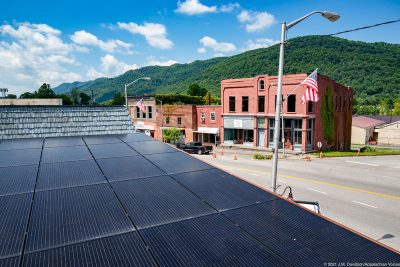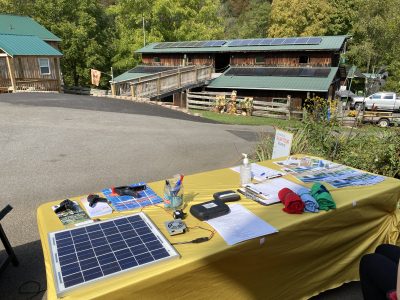Front Porch Blog
We all wish that going solar was an easy process. The truth is that it takes a mix of knowledge, experience, technical know-how and dedication. Though the process can be challenging to go through alone, communities across Southwest Virginia are making headway in kickstarting a solar energy industry through collaboration, community involvement and a lot of hard work and vision.
Below are several exciting updates on the bright future for Southwest Virginia’s growing solar energy industry, broken down into four categories: 1) residential solar, 2) commercial solar, 3) utility solar and 4) shared solar.
1) Residential solar
In 2021, the Solar Workgroup launched its second rendition of the Solarize program. Solarize Southwest Virginia focused on reducing the cost of residential solar and increasing local understanding of solar energy by helping homeowners across the region go solar together. The program included residents in Buchanan, Dickenson, Lee and Wise counties. Despite setbacks from the COVID-19 Pandemic, the program was able to find a partner in Solar Energy Solutions, headquartered in Lexington, Kentucky, to provide the opportunity for a free solar assessment to over 100 local homeowners. Installations will be taking place throughout the remainder of 2021 and into 2022.
Throughout the year, the Solar Workgroup also hosted a variety of solar education events. These included individual solar open houses in Wise and Clintwood and a tour stop on the National Solar Tour at Clinch River Farms in Tazewell County.2) Commercial solar
News regarding solar installations on schools in Southwest Virginia has also picked up recently. On October 19, the Securing Solar for Southwest Virginia Program announced that nine schools in Wise and Lee County have agreed to install a combined 3.2 Megawatts of solar panels. This would save the counties an estimated $11.5 million on energy bills over the life of the systems. In partnership with the Solar Workgroup of Southwest Virginia, the contract agreements between Wise County Schools and Secure Futures would make Wise County the first school system west of Roanoke to install commercial-scale solar panels and receive a significant portion of their electricity from solar energy. These developments can be partially attributed to the successes of local communities fighting for the rights of local schools to access no-upfront-cost financing options. Once finished, each of these projects will serve as a model for schools, hospitals and businesses across the region.
 Local small businesses have also been going solar across the region. In Big Stone Gap, Iron Works Cycling, a locally owned bike shop, installed solar in 2020 to cut their cost of electricity and to support local solar development. The 16 kW system utilized technical assistance from the Solar Workgroup and financing from solar energy development grants to make the array a reality.
Local small businesses have also been going solar across the region. In Big Stone Gap, Iron Works Cycling, a locally owned bike shop, installed solar in 2020 to cut their cost of electricity and to support local solar development. The 16 kW system utilized technical assistance from the Solar Workgroup and financing from solar energy development grants to make the array a reality.
To assist solar development across Central Appalachia, The Appalachian Regional Commission recently awarded Appalachian Voices $1.5 million for the development of the Appalachian Solar Finance Fund. The Solar Finance Fund will help support the continued growth of solar energy on commercial-scale projects such as schools, businesses or municipal buildings. By providing financial and technical support, the program will increase the potential for solar development in the coal-impacted communities of Central Appalachia. The program launches on November 4. All interested parties are invited to join the webinar for more information.
3) Utility solar
Utility-scale solar has also begun to experience a burst of energy and excitement in our corner of Virginia.
This year, Savion, LLC and Edelen Renewables announced a 75 MW solar array project in Buchanan County while seeking funding opportunities through Virginia Energy’s Abandoned Mine Land Economic Revitalization program. In September, Governor Ralph Northam and Representative Morgan Griffith announced that the program would receive funding, cementing it as one of the region’s first large-scale solar projects planned forSouthwest Virginia’s previously mined lands.
A few months later, The Nature Conservancy, in partnership with Sun Tribe Solar of Charlottesville and Sol Systems, based in Washington D.C., announced a projected 120 MW of solar energy development on previously mined lands as a part of the Cumberland Forest Project. This includes sites in Dickenson and Wise Counties.
4) Shared Solar
Though solar energy is becoming more prevalent in the region, not everyone has fair access to the region’s fun in the sun. Southwest Virginia communities are left out of the most accessible form of solar energy, shared solar. Shared solar is recognized as one of the best options for those who can not afford or otherwise install their own solar arrays. Making these programs available in Appalachian Power and Old Dominion Power service areas will allow low-income families, renters, small businesses, schools, municipalities and anyone else who wants to go solar to choose cheaper solar energy.
Communities across the region are working to make these programs available to Southwest Virginians in next year’s General Assembly. If you support solar energy for all, sign on to the shared solar letter asking legislators for their support.
To keep up with all the solar energy news across Southwest Virginia, follow the Solar Workgroup of Southwest Virginia Facebook page or sign up for the Workgroup’s email list at swvasolar.org!
PREVIOUS
NEXT
Related News

Leave a comment
Your email address will not be published. Required fields are marked *


